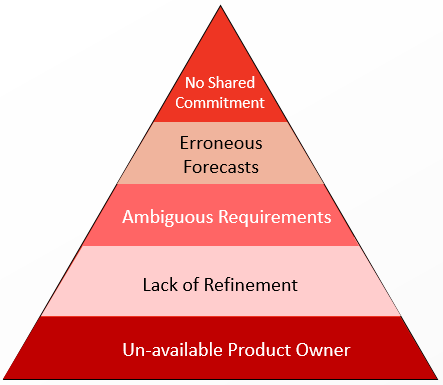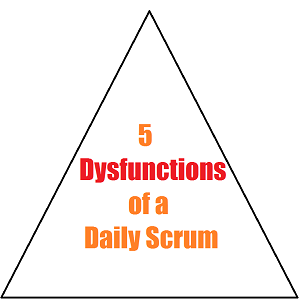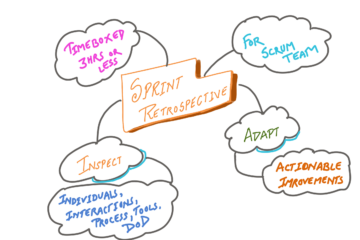To understand what are the anti-patterns for a Product Owner, one must first understand who is a Product Owner. In a nutshell a Product Owner is a visionary, accountable for the product.
According to a survey done by Forrester research, one of the main reasons for organisations failing to adopt Agile is lack of skilled Product Owners from the business. When we do not have people who are skilled enough to do what is expected from them, anti-patterns start to emerge.
In my experience I came across few such anti-patterns which I am sharing here.
Anti-pattern: In-accessible Product Owner
Symptoms:
- PO is not available for a quick feedback.
- PO is completely customer facing.
- PO is not bothered if there is quality in deliverable or not.
- PO is always busy with some other task.
Impact:
- Team makes decisions on its own.
- Team delivers features which are:
- Low Priority
- Incorrect
- Less value
Anti-pattern: Inadequate Product Backlog management
Symptoms:
- PO does not have clear vision of the product.
- Not enough PBIs are Ready to be picked up for the next sprints.
- PO does not provide clarity or does not have enough clarity on PBIs in Product Backlog
- PO does not understand how to make PBIs meet INVEST criteria.
Impact:
- Development team does not know which direction they are going.
- No transparency for stakeholders what features they should expect in upcoming releases.
- Demotivated team as things keep changing quite often.
- Development team fails to estimate the work they can do during the sprint because of lot of uncertainties around the work
Anti-pattern: Partially completed PBIs accepted
Symptoms:
- PO keeps accepting PBIs which are incomplete.
- Team also does not focus on building a releasable increment of the product.
Impact:
- Loss of transparency.
- Lack of trust within the team.
- Loss of opportunity to inspect and adapt for the team.
- Product hangs in an undone, not usable state.
- Increase in technical debt.
Anti-pattern: Failure to trust
Symptoms:
- Identify additional work for the team.
- Create stretch objectives for the team
Impact:
- Lack of trust within the team.
- Diminishing morale of the development team.
- Development team may also feel that they are micro-managed.
Anti-pattern: Product Owner is not empowered
Symptoms:
- There is a product management team that directs PO
- No single Product Owner
- Proxy Product Owner
Impact:
- Product owner is not the only decision maker which creates confusion.
- Development team unclear about whose guidance to follow.
- When Product owner is a proxy, he/she can not make any business decisions and have to be dependent on the actual PO which delays decision making.
- Stakeholders by-pass the Product Owner and involve directly with team; which may negatively impact the team.
- The decisions made by the PO may not be respected.
Anti-pattern: Quantity over quality
Symptoms:
- Doing more and more PBIs without focus on quality
- Churning the backlog without spending enough time in planning
- New PBIs get added to sprint backlog
- Focus keeps changing
- Unfinished code
Impact:
- Increase in technical debt.
- Undone work getting accumulated.
- Ability to churn out working software diminishes.
- Team morale diminishes.
- Team feels pressurized.
Anti-pattern: Estimates as deadlines
Symptoms:
- Holding team estimates as commitment
- Forcing team to adhere to estimates
Impact:
- Brings in micro management
- An environment of distrust is created
- Team may cut corners in quality to meet the estimates.
Anti-pattern: Improper stakeholder management
Symptoms:
- Stakeholders are not identified from the start.
- Stakeholders are not invited to reviews for getting feedback on time.
- Always saying Yes to all the requirements, ideas coming from stakeholders.
Impact:
- Loss of opportunities for early feedback from stakeholders.
- Not getting enough insights from the business.
- Delayed validation of ideas/concepts.
- Lack of opportunity to understand the customer perspective for the product.
There can be many more such anti-patterns happening around us, knowingly or unknowingly. As an Agile Coach or Scrum Master it becomes our responsibility to address such impediments for teams and help them get ahead on their respective agile journey.
Few remedies that have worked for me in various scenarios are as follows:
- Bring in the clarity associated with the accountability of each Role in Scrum framework.
- Create an alignment that PO is accountable for product success. For PO to succeed the entire organization must respect the decisions made by PO.
- Create a Product vision and make PO and stakeholders commit to it.
- Have some release plan in place which gives an overview in which direction we are moving.
- Emphasize on quality, help define a DoD.
- Block dedicated PO time
- Raise impediment at organization level
I hope this post might be helpful to someone.
Here is the link to my presentation on the same topic for Scrum Gurgaon event.



1 Comment
Mohit Rathore · September 27, 2017 at 5:25 pm
Nice read. very informative